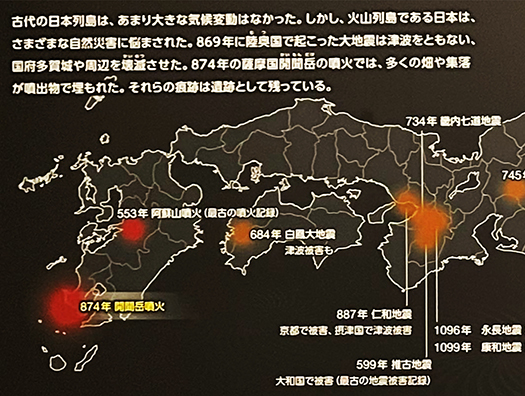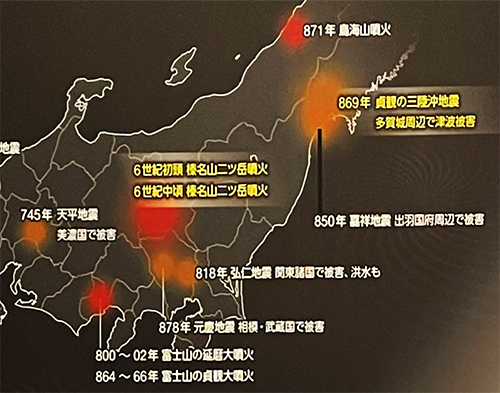

わたしたち現代人も多くの天変地異によって社会変動を経験した。
阪神淡路大震災、東日本大震災などによって社会は深甚な打撃を受けた。
現実の被害を超えて人のこころ、社会そのものにも影響をもたらせた。
国立歴史民俗博物館展示パネルでも古代での災害記録が記されている。
〜古代の日本列島はあまり大きな気候変動はなかった。しかし火山列島である
日本はさまざまな自然災害に悩まされた。869年に陸奧国で起こった大地震は
大規模な津波を伴い国府多賀城や周辺を潰滅させた。
874年の薩摩開聞岳噴火では多くの畑や集落が噴出物で埋もれた。〜
以下にパネルに表記された主な古代の自然災害。
・553年 阿蘇山噴火(記録での最古の噴火)
・599年 推古地震(大和国被害〜最古の地震被害記録)
・684年 白鳳大地震(伊予南部・津波被害も)
・6世紀初頭 榛名山二ツ岳噴火(古代豪族・上毛野氏本拠を直撃)
・6世紀中頃 榛名山二ツ岳噴火
・734年 畿内七道地震
・745年 天平地震(美濃国で被害)
・800~802年 富士山延暦大噴火
・818年 弘仁地震(関東諸国で被害、洪水も)
・864〜66年 富士山貞観大噴火
・869年 陸奧三陸沖・貞観地震と大津波(多賀城津波被害)
・871年 鳥海山噴火
・878年 元慶地震(相模・武蔵国で被害)
・887年 仁和地震(京都で被害、摂津で津波被害)
・・・国家機構として整備がされて以降の歴史年代でこうした記録。
それ以前の段階でも天変地異はもちろん多数発生していたことだろう。
そうした地震などが、祭政を司るヤマト王権にとってどのように影響したか、
現実に残された歴史経緯から想像力を巡らせるべきなのかもしれない。
6世紀初頭と中頃と記された榛名山噴火ではそれまでの古代勢力、
上毛野氏の本拠地域が壊滅的な打撃を受けたという。
古代中央軍事勢力・ヤマトタケル説話で名の残る地名
吾妻(あずま)としてはこの有力地域が眺望されたはず。
そういう吾妻中心地が潰滅したことで関東の歴史が大きく変動したと思える。
上毛野氏は古代の対外戦争でも中心的な軍事勢力として名が残るが
その後、政戦の記録からその名前が消滅し上野・下野の地名に
名前を留めるに過ぎなくなる。この榛名山二ツ岳噴火との強い関連が想像できる。
また古代の東日本大震災・貞観地震では王権の地方統治機構・多賀城が潰滅。
多賀城には関東を中心にした暴力装置・武装勢力が常駐しただろう。
その勢力の人命の多くが失われた可能性は高いと思われる。
中央政権のパワーが大きく削がれたことは疑いがない。
政治変動の基底要因としてもこうした天変地異が影響したと考えられる。
歴史年代として記録の残る時代でもこうした想像が可能だが
それ以前の社会でも自然災害はさらに大きな要因として働いたに違いない。
English version⬇
Ancient History and Earthquakes, Eruptions, and Natural Disasters: The 37,000-Year History of the Japanese Islands – 48
Numerous disasters have been recorded even after the age of historical records. Even before that, they occurred constantly and frequently. They must have had a strong influence on the mind and history. ・・・・.
We modern people have also experienced social changes due to many natural catastrophes.
The Great Hanshin-Awaji Earthquake, the Great East Japan Earthquake, and other disasters dealt a profound blow to society.
Beyond the actual damage, these disasters also had an impact on the human mind and society itself.
The National Museum of Japanese History exhibition panel also records disasters in ancient times.
〜The Japanese archipelago in ancient times did not experience major climatic changes. However, as a volcanic archipelago
In 869, a major earthquake occurred in Rikugunkoku, which was accompanied by a massive tsunami.
In 869, a major earthquake in Riku-Onkoku was accompanied by a massive tsunami that destroyed Tagajo, the national capital, and the surrounding area.
The eruption of Mt. Kaimondake in Satsuma in 874 buried many fields and villages in the eruption. ~.
The following are the major ancient natural disasters described in the panel.
Eruption of Mt. Aso in 553 (the earliest recorded eruption)
599 Suiko Earthquake (damage in Yamato Province – oldest record of earthquake damage)
684: Great Hakuho Earthquake (also caused tsunami damage in southern Iyo)
Early 6th century: Mt. Haruna Futatsudake eruption (hit the home of the ancient Kamimono clan)
Eruption of Mt. Haruna Futatsudake in the mid-6th century.
734 Kinai-Shichido Earthquake
745 Tenpyo Earthquake (damage in Mino Province)
800~802: Enryaku volcanic eruption of Mt.
818 Konin Earthquake (damage and flooding in Kanto region)
864-66: Great eruption of Mt.
869: Jogan earthquake and tsunami off the coast of Riku-On-Sanriku (damage from Tagajo tsunami)
871: Eruption of Mt.
878: Genkei Earthquake (damage in Sagami and Musashi Provinces)
887 Niwa Earthquake (Damage in Kyoto, Tsunami damage in Settsu)
These records are from the period after the establishment of the national organization.
Of course, there must have been many natural disasters even before that.
How such earthquakes affected the Yamato kingdom, which was in charge of ritual administration, is not clear.
Perhaps we should use our imagination to determine how such earthquakes and other events would have affected the Yamato royal government, which controlled the rituals.
The eruption of Mt. Haruna in the early and middle of the 6th century destroyed the ancient power that had been in power until then, the Kamimono clan.
The eruption of Mt. Haruna in the early to mid-6th century is said to have devastated the home region of the Kamomono clan, the ancient power that had been in power until that time.
Place names that remain in the legend of Yamatotakeru, the ancient central military force
This area must have been viewed as Azuma.
The destruction of the Azuma center is thought to have caused major changes in the history of the Kanto region.
The Kamimono clan’s name remained as a major military force in the ancient wars against Japan, but the records of political battles show that the Kamimono clan’s name did not change.
Later, their name disappeared from the records of political wars, and they were only mentioned in the names of places in Ueno and Shimono.
The name of the Jomono clan has remained only in the names of places in the Ueno and Shimono regions. It can be imagined that there is a strong connection with the eruption of Futatsudake on Mt.
In addition, the ancient Great East Japan Earthquake of Jogan destroyed Tagajo, the local seat of royal rule.
The Taga Castle would have been the permanent seat of a violent apparatus and armed forces centered in the Kanto region.
It is highly likely that many of the lives of those forces were lost.
There is no doubt that the power of the central regime was greatly reduced.
Such natural cataclysms are also thought to have been a fundamental factor in political change.
It is possible to imagine such an event even in the recorded historical period, but even in earlier societies
Natural disasters must have been an even more significant factor in earlier societies.
Posted on 12月 21st, 2022 by 三木 奎吾
Filed under: 日本社会・文化研究, 歴史探訪







コメントを投稿
「※誹謗中傷や、悪意のある書き込み、営利目的などのコメントを防ぐために、投稿された全てのコメントは一時的に保留されますのでご了承ください。」
You must be logged in to post a comment.